|
August 18, 2015
Skirting - A whole New Animal
Value Added Skirting Fleece Improves Profit
By: Michael A. Morack
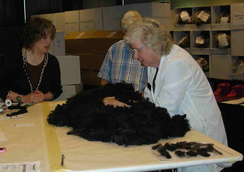
Sara Jane showing fleece features to Marge.
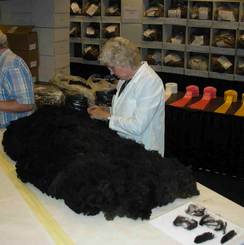
Sara Jane Maclennan selecting samples.
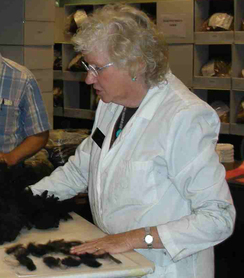
Sara Jane Maclennan assessing final score.
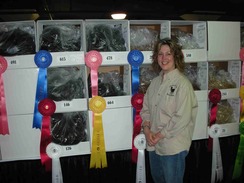
2009 World Fleece Show-Mondavi's 4th.
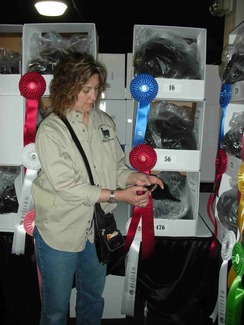
2009 World Fleece Show-Ayashe's 3rd.
We sheared our prize alpaca – prized because he received red and blue ribbons in every halter class he entered and because the judges all agreed, “you have a good one there.” The fleece, the reflection of this alpaca, was an extension of the halter show ring, so the preparation of the fleece, skirting, was no different than our preparation for the halter ring. Get the Beans out!
We rolled the fleece onto the skirting table when the debate between my wife and I began. How much, and what should be removed during skirting? Differing experiences and impressions send us to neutral corners and we defend our experience. My thought was to preserve the weight of the fleece and only remove second cuts. Marge felt that weight preservation was important, but was not as important as the removal of second cuts and fleece that did not represent the overall fleece in crimp, color, texture, and appearance. We negotiated a compromise. Perhaps this sounds familiar.
Prepared and ready for the show, we filled out the entry forms, packaged the fleece, and departed for the 2010 Nationals in Ft. Wayne, Indiana ready for our next red or blue with our champion Huacaya.
We volunteered to assist in fleece judging at the 2010 National’s but our volunteerism resulted in more learning for us rather than the little effort we contributed. We were assigned Sara Jane Maclennan’s table. As Sara Jane judged fleece after fleece, you got a sense that she was pulling the best from each fleece, rooting for each to be the best. Always present in her demeanor was a desire to provide insight in her assessment so that the entrant learned how to present their best at their best. Whenever possible, she provided comments for each fleece stating what was most pleasing about a particular fleece and when necessary, pointing out why the fleece may have been marked down in certain areas.
She pulled one particular fleece from its bag and flung it upon the table and stepped back awed by what laid on the table. She called to Diana Timmerman working at the adjacent table, to take a look at this beautiful fleece. Diana stepped over and was equally impressed by the fleece lying on the table. No question this was the finest fleece opened to that point and turned out to be a champion and contention for Judge’s Choice.
The fleece weight contributed to the final score, but other characteristics, fineness, handle, uniformity, style, brightness, and lack of guard hair, impurities, stain, and damage guaranteed a top score. Sara Jane pointed out how well the fleece had been prepared.
The importance of proper preparation made sense as she pulled the next fleece in the group and flung it open on the table. Again, we all were impressed with the immediate quality of the fleece and started thinking, this would compete for top honors with the last fleece she had scored until right in the middle Sara pulled a brown clump of fleece that looked strangely foreign to the overall fleece and set it aside on the table. She then began her regimen of selecting samples from various areas on the fleece to help her final assessment. As she did, she started pulling more and more fleece samples that were not representative of the overall fleece until she had a considerable pile next to her.
She stepped back and addressed the volunteers. “This really makes me sad. Here is a beautiful fleece, as nice as the last fleece, but because it was not prepared as well or the owners did not want to reduce fleece weight, I end up with a pile of fleece that does not represent the product before us. Although they may score well in weight, this fleece looses many points in fineness, handle, uniformity, style, brightness, and lack of guard hair, impurities, stain, and damage. Very sad.”
This fleece did score well in spite of the skirting issues, and was in competition for the Color Banners however, it lost to the two champion fleeces scoring 1.5 points less than the Color champion and .5 points less than the Reserve Champion. Sara Jane again stated, “This is so sad. Here is a beautiful fleece that if it had been prepared a little better would most likely have taken a banner and perhaps Judge’s Choice but I must assess the fleece in entirety as presented before me on that given day.”
The negotiated compromise with Marge was getting a foothold in my thoughts along with Sara Jane’s insights. I had this nagging desire to find our entries and slip off for the preparation I now knew we should have done and knew I had some well-deserved Crow coming my way. I realized when the fleece was separated from the alpaca it became a product, a product that had little representation of the alpaca from which it was harvested. That fleece needed to be prepared as a product.
A product. Now that was an epiphany! I was no longer preparing an animal for show but preparing a product for maximum value to be cleaned, spun, and woven into a fabric that would eventually become a garment. The product is assessed for maximum value, a value defined not by breeding choices but by end use and quality.
In order to obtain maximum value it was my job to prepare - skirt the fleece. If I left damaged or filthy fiber, mismatched fiber in color or texture, or fibers that were not representative of the overall fleece, the value of the overall fleece is reduced. In the show ring this may mean the difference between a banner and stating in marketing that the alpaca was right behind the Color or Reserve Champion. In sales, it means the difference between receiving $32 / pound verses $24 / pound.
Put in terms of dollars and cents might make the most sense. If we leave a pound of fiber that should have been skirted that reduced the price by $12 / pound, we gain $12 by leaving the unskirted fiber, but we loose $60 on a five pound fleece.
Now that made sense! Dollars! Loosing $60 per fleece meant the difference between breaking even raising alpacas verses loosing money on the venture. At the National’s that meant the difference between one fleece receiving a banner and the other a comment, “Skirting better would have improved the score.” We prepared
the fleece much differently for the 2011 Denver Nationals and you can bet I listened to Marge and skirt, skirt, skirt.
|